 This is a post I've been wanting to put together for a while. Hopefully the phase 1 report from the Youth Work and Social Networking project I'm co-researching with Pete Cranston will be out soon (sending if off for formatting tomorrow…) – but as that looks like it will be about 15,000 words of literature review, survey and focus group write up, I thought it would be useful to put together a list of the literature that has most influenced or challenged my thinking.
This is a post I've been wanting to put together for a while. Hopefully the phase 1 report from the Youth Work and Social Networking project I'm co-researching with Pete Cranston will be out soon (sending if off for formatting tomorrow…) – but as that looks like it will be about 15,000 words of literature review, survey and focus group write up, I thought it would be useful to put together a list of the literature that has most influenced or challenged my thinking.
The works below may not explicitly address young people and social networking directly, but they all offer useful context and insights. I can't promise that I've managed to adequately take account of them all in my writing (indeed, I'm quite aware that I haven't – for that I'd need to be working on this full time rather than having the day or so a week I have right now) – but I hope that offering a summary of them here helps others in following these trains of thought….
Perspectives on online social networking and social network sites:
1) boyd & Ellison: Social network sites: Definition, history, and scholarship.
I've been to far too many events lately which have billed themselves as talking about social networking when in fact presentations and discussions have covered just about anything internet related but social networking. boyd and Ellison's formal definition of social network sites is a really helpful 'centre of gravity' for thinking about online social networking, and the discussion on danah boyd's blog post on the subject is particularly useful.
For the Youth Work and Social Networking project we tried to look at the activity of online social networking, through in effect our focus was on social network sites (although in an ideal world we would have been able to extend our investigation to online social networking with gaming etc.).
2) Larsen: 35 Perspective on Online Social Networking
I only found Malene Larsen's work half-way through putting together the Youth Work and Social Networking project – but it provides some fantastic insights and and conceptual frameworks for looking at online social networking. The 35 Perspectives on Online Social Networking are a particularly useful tool for reflection in thinking about the wide range of responses different organisations and individuals have to social networking (ranging from the 'consumer perspective' and 'body and sex perspective' through to the 'friendship perspective' and the 'group work perspective'.
Social networking, youth and identity:
3) Larsen: Understanding Social Networking: On Young People's Construction and Co-Construction of Identity Online
The fourth perspective Larsen introduces is 'The identity perspective' – “Social networking sites are spaces for identity construction. Here, young people continuously constructing, re-constructing and displaying their self-image and Also, the network sites make them co-constructors of each other’s identities.” That gets a far deeper exploration in this ethnographical exploration of MySpace-like Danish social networking site Arto.
4) Stern: Producing Sites, Exploring Identities: Youth Online Authorship
Susannah Stern's article isn't about social network sites. It's about young people creating personal homepages and blogs – but it's exploration of how homepage creation facilitates identity formation and reflection upon identity formation is extremely interesting. It raises interesting questions about whether or not social network sites also provide young people with a canvas for self reflection or not.
5) Donnovan: Whose Safety? Whose Security? (forthcoming)
Gregory Donnovan's work explores the problematic nature of box-filling social network site profiles and the way in which the reductive nature of profiles (for example, being asked to sum up religious belief, political affiliation or relationship status in a single line) can harm identity formation. Donnovan also raises important questions about how a growth in young people living out lives online potentially increases opportunities for state control of childhood, rather than increasing young people's freedom from control. Similar questions about the increasing power and control afforded to corporations through young people's engagement with online social networks may be asked.
6) Solove: The future of reputation: gossip, rumour, and privacy on the internet
Solve doesn't address social networking explicitly – and in fact the elements I found most interesting in his book are a little less developed than I'd like – but he does raise a number of crucial points about the way notions of privacy may be being redefined by the internet, and about the risks of publishing information online in preventing people from escaping past misdemeanour's that may be of particular interest to those working with young people. Will we see the availability of data about people's pasts becoming anchors that tie them down? Or will a norm that accepts everyone has a data-trail emerge?
7) Ellison, Steinfield, Lampe: Spacially Bounded Online Social Networks and Social Capital: The Role of Facebook
What is the role of online social networks in reflecting, and contributing to, young people's social capital resources? If local social networks have a significant impact on educational aspiration and attainment (as The JRF found they do) then exploring the role of online social networks seems to be a useful line of enquiry…
Responses to online social networking
8) Wolak, Finkelhor, Mitchell, Ybarra: Online “Predators” and Their Victims – Myths, Realities, and Implications for Prevention and Treatment and 9) Ybarra et. al: Internet Prevention Messages: Targetting the Right Online Behaviours
The Crimes Against Children Research Centre (CCRC) have produced some fantastic research which is extremely helpful in trying to find a balanced response to risk online. Their work drawing on the US based Second Youth Internet Safety Survey gets beyond the unhelpful blunt (and possibly counter-productive) safety guidelines commonly given to young people such as 'Don't share any personal details online' to look at the real markers of risk (for example, “Talking with people known only online (“strangers”) under some conditions is related to online interpersonal victimization, but sharing personal information is not.“) and to develop guidance and recommendations that make a lot of sense. In fact, two points from the bulleted summary on the CCRC Internet page are worth quoting in full:
- Focus prevention efforts more on adolescents, less on parents, and frankly on concerns relevant to adolescents, including autonomy, romance and sex.
- Focus prevention more on interactive aspects of Internet use and less on posting personal information.
I would strongly suggest that no-one should be proposing online safety messages without looking at these and other CCRC articles.
10) Merton: Good Youth Work: What youth workers do, why and how
When I first read Bryan Merton's 'Good Youth Work' I scribbled furiously in the margins about the lack of referencing and got frustrated about the complete reliance on anecdote and stories to explain what youth work does. However, having spent time over the Youth Work and Social Networking project talking with youth workers, and exploring possible youth work responses to online social networking – I've come to find it does provide a strong insight into how good youth work responses to online social networking could have an lot to offer (although it would still be good to see youth work adopting more explicit frameworks to be able to describe what it does).
Crucially, where a lot of focus gets put onto information campaigns and formal education to support young people in making safe and effective use of online social networking, informal education approaches are often not given enough consideration. Providing space for reflection, group work interventions, and individual interventions at the right time could potentially achieve a lot more than any amount of lesson plans, safety videos and even media literacy classes.
Well, that's 10 articles for now. But I'd be interested to hear from readers of this post – what article or resources are inspiring you to explore different lines of thought about youth and online social networking right now?
Photo credit: Piles of books by Ollily
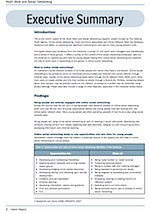 Just a quick pointer to the
Just a quick pointer to the  Over at the newly arrived 2gether08 website
Over at the newly arrived 2gether08 website 
 Right now the FAIRTRADE Mark tells me about the original commodity producer – but it doesn't tell me the whole story. For example, I don't know the conditions in which the Fairtrade Cotton trousers I bought from M&S the other day were made – and whilst I know that the farmer of the coffee I'm drinking got more for her work that she would have selling a non-fair trade product – I don't know how much of the money went to the farmer.
Right now the FAIRTRADE Mark tells me about the original commodity producer – but it doesn't tell me the whole story. For example, I don't know the conditions in which the Fairtrade Cotton trousers I bought from M&S the other day were made – and whilst I know that the farmer of the coffee I'm drinking got more for her work that she would have selling a non-fair trade product – I don't know how much of the money went to the farmer.  Ever since I first saw the
Ever since I first saw the  On Friday Ofcom published their
On Friday Ofcom published their  This is a post I've been wanting to put together for a while. Hopefully the phase 1 report from the
This is a post I've been wanting to put together for a while. Hopefully the phase 1 report from the  First off, appologies for my lack of blogging of late. There's a lot to blog, but I'm having to put all my time into getting a few big projects rounded off right now.
First off, appologies for my lack of blogging of late. There's a lot to blog, but I'm having to put all my time into getting a few big projects rounded off right now.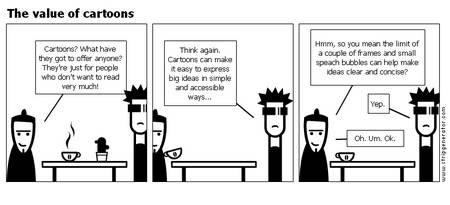
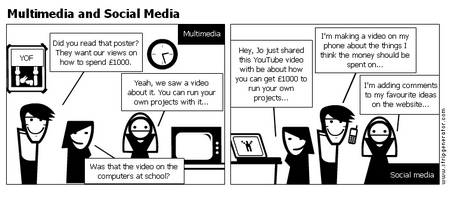
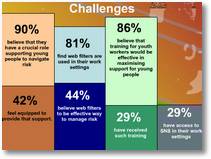 On Monday I gave a presentation to the
On Monday I gave a presentation to the 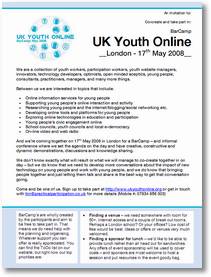 [Summary: you are invited to join in a free informal conference to talk about young people, the internet, opportunities, challenges, and change]
[Summary: you are invited to join in a free informal conference to talk about young people, the internet, opportunities, challenges, and change]